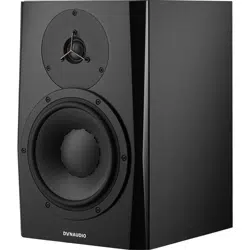Loading ...
Loading ...
Loading ...

Final Tweaks
Beyond the settings for the loudspeakers, additional tweaks may be desired to improve the response of the
system and room environment. You may discover that a reflective surface is causing a high frequency anomaly or
perhaps room modes are disturbing the bass response in the room.
First Reflection Treatment
Sound reflecting o of hard surfaces that are close to the listening position can cause problems in the high
frequency response and imaging of the loudspeakers. These first reflections can be relatively easy to fix in many
cases. Figure 7 shows some common causes of first reflections in a typical control room.
First reflections can be located easily by using a mirror placed on various surfaces in the studio to check if you
can see either loudspeaker in the mirror when sitting in the listening position. If you can see either loudspeaker in
the mirror, it follows that upper frequencies will bounce o that surface directly back to the listening position and
potentially cause response problems.
Placing absorptive material on these surfaces will reduce the eect of first reflections and improve the sound of
the system. The thicker the acoustic material is, the more eective it will be. Also, creating an air space behind the
material will improve its eectiveness. Place as much absorption that is practical at the first reflection points to
improve the response of the system.
Bass Trapping
If you notice any peaks or dips in the low frequency response curve of the RTA (20-250 Hz), they may be caused
by room modes. Room modes occur at specific low frequencies that have wavelengths that are equal to or
multiples of the dimensions of the listening room.
For example, if the listening room is 4 meters long, there may be a room mode at 43 Hz since its wavelength is
about 8 meters. What this means is that for this frequency, the room response will change dramatically depending
on the position of the listener and the loudspeaker. You may hear a more of this frequency or less of it depending
on the listening position in the room. Modes can be formed from all dimensions of the room; length, width, and
height. The solution is to place sound absorption designed for low frequencies in the most eective places to
reduce the eect of room modes.
Many manufacturers make sound absorptive devices called bass traps that are designed to be placed in or near
corners and will reduce the amount of reflected low frequency energy in the room. By dampening the resonance
of the modes, the low frequency response of the room may be smoothed out.
When placing bass traps, always check the resulting frequency response curve with pink noise and an RTA to
ensure that the loudspeaker response is improving. Then listen to your favorite reference material to see how this
aects it.
Final Tweaks 21
Loading ...
Loading ...
